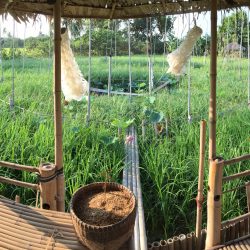WITH ARTIST WIJIT APICHARTKRIENGKRAI’S LONG-STANDING ROLE AND PARTICIPATION IN THE PUBLIC ART COMMUNITY, THE OBJECTIVE OF HIS STUDY AND EXPLORATION OF RICE-RELATED CULTURE ENCOMPASSES A SEARCH FOR THE PRESENCE OF AESTHETIC THEORIES SUCH AS RELATIVE AND CONVERSATIONAL AESTHETICS.
The Art Project of Ecological Aesthetic in Thai Rice Culture is a part of Wijit Apichartkriengkrai’s PHD thesis at the Faculty of Painting and Sculpture, Silpakorn University. With the veteran artist’s long-standing role and participation in the public art community, the objective of his study and exploration of rice-related culture encompasses the search for meaning and relationship between ecology, art and the presence of aesthetic theories such as relative and conversational aesthetics. Artists and farmers ‘co-created’ Ecological Aesthetic on a 3200-square-meter piece of land in the Nakonchaisri district of Nakhonpathom province. Physically, the field was inspired by the concept and physical characteristics of a terraced rice field with the addition of a circular outdoor stage, Anodad pool and Himmavanta Forest inspired by Buddhist Mythology. The artist experiments with the rice culture of the past by paying respect to the Phosop goddess, the land’s guardian spirit, making merit for the field’s prosperity, and the ‘Long-keak’ tradition where community members help each other during the annual harvest. These norms and traditions are incorporated into the artistic process through the creation of Puang Ma-hod, Thai traditional paper garlands, and flags used for decoration of the paddy field. Such participative process aims to teach and keep the general public aware and recognizant of the significance of the country’s rice culture.

Image courtesy of Wijit Apichartkriengkrai

Image courtesy of Wijit Apichartkriengkrai
One of the conclusions materialized from the study is a new form of appropriateness and the many dimensions it brings. Relationship-wise, the artist and farmers collaborate as creative partners and consequently both parties’ preconceived notions of beauty and aesthetics change through such collaboration. Artistically, Ecological Aesthetic combines the nature of a living sculpture commonly used in the artistic process of Public art. From the academic point of view, it’s an interesting mixture of action research and art whereas as a creative platform, Ecological Aesthetic serves as a space where knowledge and experiences of people from various disciplines, from artists, designers, ecologists and agriculturists to local governing authorities and the general public, are shared and exchanged.

Image courtesy of Wijit Apichartkriengkrai
TEXT: SUPITCHA TOVIVICH
www.facebook.com/wijit.thaifarm




